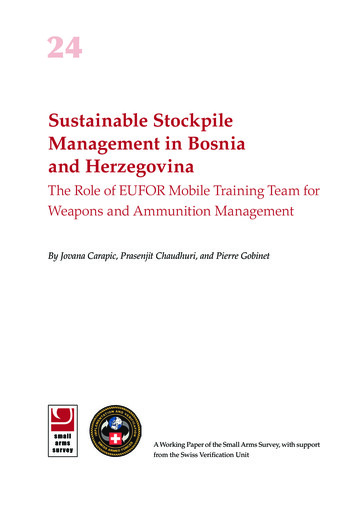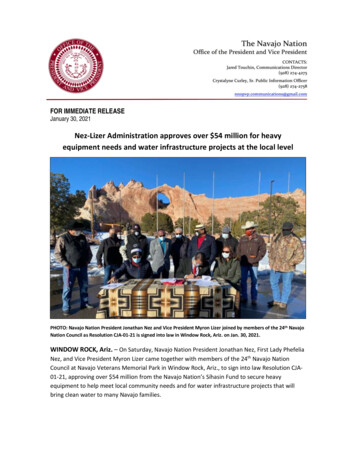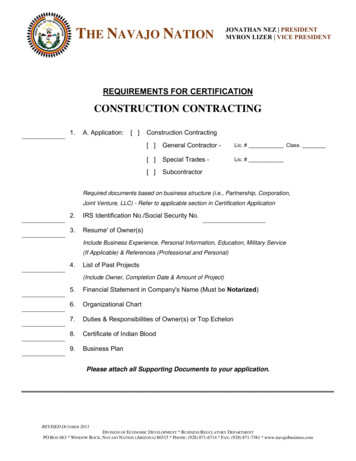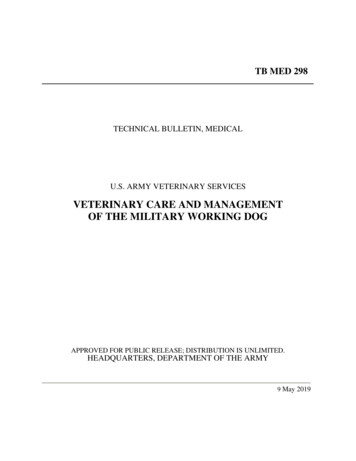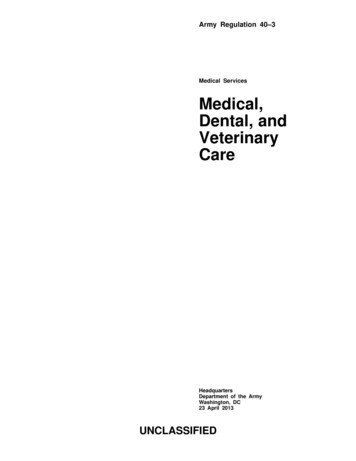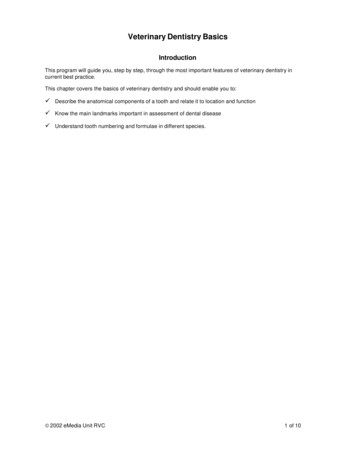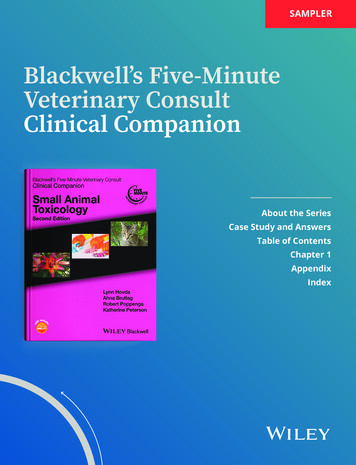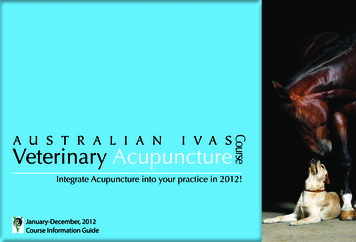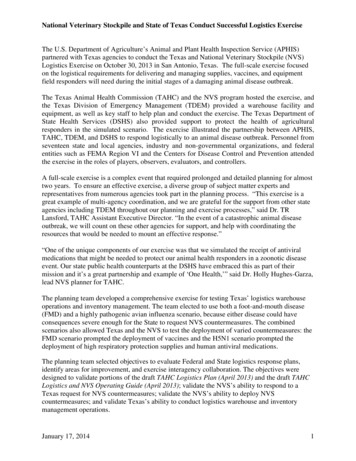
Transcription
National Veterinary Stockpile and State of Texas Conduct Successful Logistics ExerciseThe U.S. Department of Agriculture’s Animal and Plant Health Inspection Service (APHIS)partnered with Texas agencies to conduct the Texas and National Veterinary Stockpile (NVS)Logistics Exercise on October 30, 2013 in San Antonio, Texas. The full-scale exercise focusedon the logistical requirements for delivering and managing supplies, vaccines, and equipmentfield responders will need during the initial stages of a damaging animal disease outbreak.The Texas Animal Health Commission (TAHC) and the NVS program hosted the exercise, andthe Texas Division of Emergency Management (TDEM) provided a warehouse facility andequipment, as well as key staff to help plan and conduct the exercise. The Texas Department ofState Health Services (DSHS) also provided support to protect the health of agriculturalresponders in the simulated scenario. The exercise illustrated the partnership between APHIS,TAHC, TDEM, and DSHS to respond logistically to an animal disease outbreak. Personnel fromseventeen state and local agencies, industry and non-governmental organizations, and federalentities such as FEMA Region VI and the Centers for Disease Control and Prevention attendedthe exercise in the roles of players, observers, evaluators, and controllers.A full-scale exercise is a complex event that required prolonged and detailed planning for almosttwo years. To ensure an effective exercise, a diverse group of subject matter experts andrepresentatives from numerous agencies took part in the planning process. “This exercise is agreat example of multi-agency coordination, and we are grateful for the support from other stateagencies including TDEM throughout our planning and exercise processes,” said Dr. TRLansford, TAHC Assistant Executive Director. “In the event of a catastrophic animal diseaseoutbreak, we will count on these other agencies for support, and help with coordinating theresources that would be needed to mount an effective response.”“One of the unique components of our exercise was that we simulated the receipt of antiviralmedications that might be needed to protect our animal health responders in a zoonotic diseaseevent. Our state public health counterparts at the DSHS have embraced this as part of theirmission and it’s a great partnership and example of ‘One Health,’” said Dr. Holly Hughes-Garza,lead NVS planner for TAHC.The planning team developed a comprehensive exercise for testing Texas’ logistics warehouseoperations and inventory management. The team elected to use both a foot-and-mouth disease(FMD) and a highly pathogenic avian influenza scenario, because either disease could haveconsequences severe enough for the State to request NVS countermeasures. The combinedscenarios also allowed Texas and the NVS to test the deployment of varied countermeasures: theFMD scenario prompted the deployment of vaccines and the H5N1 scenario prompted thedeployment of high respiratory protection supplies and human antiviral medications.The planning team selected objectives to evaluate Federal and State logistics response plans,identify areas for improvement, and exercise interagency collaboration. The objectives weredesigned to validate portions of the draft TAHC Logistics Plan (April 2013) and the draft TAHCLogistics and NVS Operating Guide (April 2013); validate the NVS’s ability to respond to aTexas request for NVS countermeasures; validate the NVS’s ability to deploy NVScountermeasures; and validate Texas’s ability to conduct logistics warehouse and inventorymanagement operations.January 17, 20141
National Veterinary Stockpile and State of Texas Conduct Successful Logistics ExerciseTwo months prior to the exercise, NVS personnel conducted logistics training in Austin, Texasto teach exercise participants about warehouse operations and inventory management functionsthey would perform during the exercise. The training also gave players an opportunity to reviewtheir exercise roles and practice key functions.The exercise kicked off on October 25th with state and federal animal health officials receivingthe scenario through a series of emails. Animal health officials in the TAHC, APHIS VSWestern Region, and the Texas VS Area office made the decision that NVS countermeasureswere needed to respond to the scenario. The NVS headquarters staff validated the NVS requestprocess in real-time. During the request process, all entities provided the required information torequest an NVS deployment.The supply unit leader and his staff prepared the warehouse on October 29th to receive deployedNVS countermeasures and simulated FMD vaccine, and to manage inventory. Preparationsincluded mobilizing staff, preparing for warehouse activities, and coordinating with other keyincident command staff and technical specialists. The ordering manager uploaded the NVSshipment file in preparation to receive the countermeasures.NVS deployed countermeasures and an NVS mobile logistics team (MLT) to the San Antoniowarehouse on October 30th to support warehouse logistics operations for the simulated FMD andH5N1 response. A series of briefings kicked off the exercise. Participants were prepared for theday’s schedule and informed about the exercise scenario, the resources required to respondimmediately, and the justification to request Federal assistance from the NVS program.Following the briefings, the tractor trailer containing NVS countermeasures for the exercisebacked up to the warehouse door and the warehouse play began. Players reacted to exerciseinjects and took the necessary actions to respond to a variety of simulated circumstances. Thereceiving and distribution manager directed warehouse teams to offload the shipment using aforklift, inspect for damages and shortages, and store each tri-wall container in its predeterminedstorage location on the warehouse floor. The ordering and inventory managers remained busyresponding to injects throughout the exercise that required inventory controls. They processedrequests for supplies from responders in the field, generated pick sheets, monitored and adjustedon-hand balances, and forwarded reorder requests while managing other tasks.Multiple injects for the warehouse teams required them to pick a variety of supplies from theNVS 24 hour push packs, move them to staging, and prepare them for distribution to fieldresponders. The NVS shipment contained simulated FMD vaccine which required specializedcold chain management. Warehouse teams quickly unloaded the simulated vaccine, checked itstemperature to ensure the required temperature was maintained during transit, conductedinventory, and quickly stored it in the NVS mobile refrigeration unit.Exercise observers were provided the opportunity to view the exercise from designatedobservation areas. The injects and expected actions were reviewed with the exercise play,providing observers with the details of the day’s activities as they unfolded. As the exercisecame to a close, the warehouse facility was shut down and returned to normal operations.During this time, warehouse teams and managers conducted actions to return accountable NVSJanuary 17, 20142
National Veterinary Stockpile and State of Texas Conduct Successful Logistics Exercisecountermeasures to the warehouse, pack and prepare them for return, and load them back ontothe tractor trailer for return shipment to the NVS program. All exercise participants wereinvolved in the hotwash to identify positive attributes, areas for improvement, and lessonslearned. The exercise was planned, designed, and conducted in accordance with guidance fromthe U.S. Department of Homeland Security Exercise and Evaluation Program (HSEEP).The Texas and NVS logistics exercise succeeded in training players to request, receive, andmanage NVS countermeasures. The advanced NVS logistics training session allowed exerciseplayers to learn their duties and enhanced cooperation among all organizations. The exercise wasalso successful at validating portions of the draft TAHC Logistics Plan (April 2013) and the draftTAHC Logistics and NVS Operating Guide (April 2013) for the first time. Participants receivedvaluable hands on experience that will help Texas leaders finalize the Texas plan and operatingguide. The exercise also provided an opportunity for NVS personnel to test their capabilities tosupport a State request for assistance, particularly the new mobile refrigeration unit. Overall, theexercise was an excellent training and team-building event.According to Rodney White, NVS Director, “This full-scale exercise demonstrated thecommitment of the NVS program to support our state animal health partners. It providedemergency responders in Texas an opportunity to have hands-on experience working with NVScountermeasures they would need in the event of an animal disease outbreak, and allowed anequal opportunity for NVS personnel to respond as they would in a real emergency.”The NVS is the national repository of critical veterinary supplies, equipment, animal vaccines,and services that can be deployed to the site of a damaging animal disease outbreak within 24hours. A major goal of the NVS program is to help states, tribal nations, and U.S. territoriesplan, train, and exercise for the receipt, management, and distribution of NVS countermeasuresduring a logistics emergency response.All states, tribes, and U.S. territories are encouraged to develop a written NVS plan to ensureresponders receive the NVS countermeasures they need. For planning tools, question andanswer documents, and other information, visit the NVS website at http://nvs.aphis.usda.gov.January 17, 20143
National Veterinary Stockpile and State of Texas Conduct Successful Logistics ExerciseJanuary 17, 20144
National Veterinary Stockpile and State of Texas Conduct Successful Logistics ExerciseJanuary 17, 20145
National Veterinary Stockpile and State of Texas Conduct Successful Logistics ExerciseJanuary 17, 20146
National Veterinary Stockpile and State of Texas Conduct Successful Logistics Exercise . Two months prior to the exercise, NVS personnel conducted logistics training in Austin, Texas to teach exercise participants about warehouse operations and inventory management

